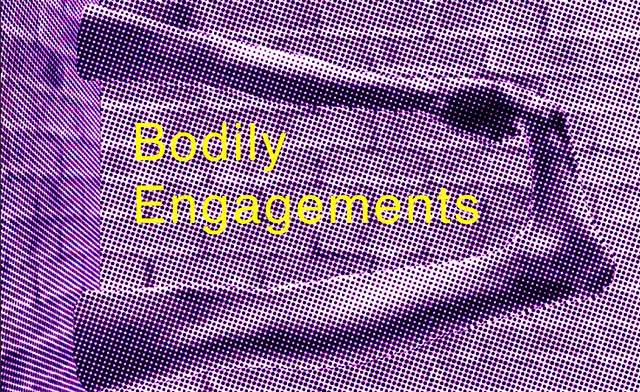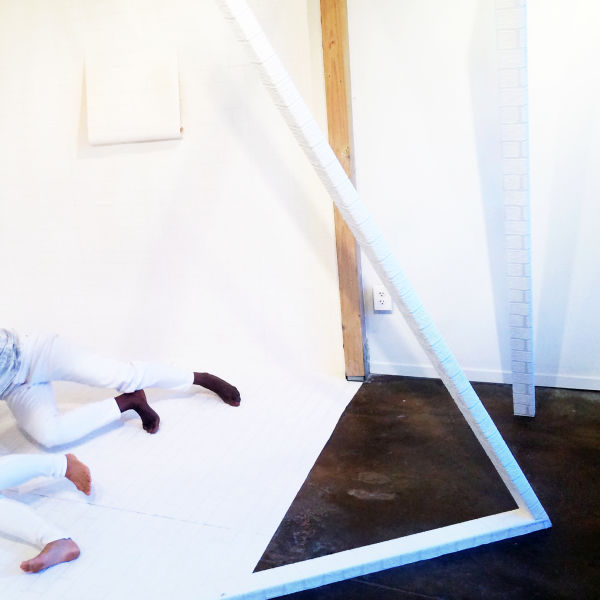In Temescal Alley, the historic lane turned hip North Oakland marketplace, Interface Gallery hosts Bodily Engagements, an eight-week series of interdisciplinary and experiential performance projects. Attending to the theme of the human body in its spatial, visual and temporal relationships, Bodily Engagements hosts four onsite projects of dance, performance and installations.

Making Plain is the third project in the series, an installation and performance by Manners (visual artist Lisa Rybovich Crallé and artist/performer Sophia Wang). The project features a site-specific movement piece developed over a series of workshops, choreographed by Wang with Olive Blackburn and Titania Kumeh. The final piece will be performed by all three dancers on Feb. 27, 5-6pm, accompanied by an audio piece by (((arc))), the sound project of film artist Tooth, to be debuted that evening.
All these moving parts might seem complicated, but the democracy of the artists’ process flows smoothly through each component. Unique additions from each participant are essential, manifesting a harmonious creative environment that honors experimentation and variation.
Crallé’s installation — open for viewing during regular gallery hours — dominates the small space, but the room remains airy. The walls are covered in white paper printed with a thick, impasto pattern of white bricks. Stretching onto the concrete floor, the paper extends across the room, creating an illusion that is broken by two scroll-like pieces of paper hanging on the wall.
Crallé’s brick-patterned paper references the gallery’s own walls, completely hidden by the installation. Amplifying this characteristic creates an impression beyond the meta reference: the result is something institutional, almost reminiscent of padded walls of a sanitarium, a tiled hospital room, or (perhaps less threatening) a communal bathhouse. The handcrafted mark of the pattern, however, disrupts the environment’s austerity. And, perhaps more than anything, the quirky, unexplained forms zig-zagging across the room animate the space.

Three geometric shapes, made of wood outlines covered in the patterned paper, jut into and cut through the room. The angles create framing devices for viewers and curious obstacles for the dancers when they enter the room. The performers engage the shapes as possible cues for their own posture, steps and travels — all the while wearing matching white-brick printed attire, a continuation of Crallé and Wang’s examination of camouflage in their joint artistic practice.
Blackburn, Kumeh and Wang allow themselves to react to the room and each other through a series of pre-established movement sequences. In one sequence, Kumeh and Wang press closely against each other’s bodies in a stilted shuffle, an intimate yet imperfect matching of their movements. Yet another exercise found Kumeh mirroring Wang’s crab-like walk as their two bodies dissonantly march at a strange angle. Blackburn, across the room, likewise responds to their shapes with her own shifts. In this sequence, the angle of their legs suggests a fictional plane of space across which they might be crawling.
The title Making Plain becomes a pun in which the performers create the illusion of new dimensional planes for their movement. But the title, too, might indicate the transparency of their collaborative process, since Manners opened two of their workshops to the public (Feb. 19 and 20). Plain, too, could be the blankness of a white-walled gallery space made strange by the installation’s paper sprawl.
Such conceptual puns seem to fit Manners’, well, manner. Manners are the ways we behave towards others within an established set of rules, but they also indicate the possible eccentricities within. Making Plain puts on view the ways in which the dancers become fully absorbed into the constructed scene, and enter into a spatial relationship with each other.
Facing a corner, each other or a wooden shape, they each seem to fall into another dimension of play and expression, entranced within their series of reactions. As a collaborative and interdisciplinary project, Making Plain reflects the ways that each individual — choreographer, dancer, visual artist, sound artist — might interpret an established set of parameters. The project is an inexact structure open to disharmony and imperfections, which seem to be fully embraced as an essential part of the process. Making Plain emerges as a whole-hearted, nearly utopic exercise in giving each participant’s voice value in the creation of an experience.
Making Plain is on view at Interface Gallery in Oakland through Feb. 28, 2016, with a public performance on Feb. 27, 5-6 pm. For more information visit interfacegallery.com.